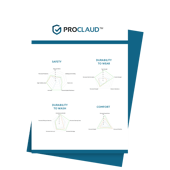As a health and safety professional, you have a lot of responsibilities. Choosing the right protective clothing for employees is just one of them. You know that there is more to it than just ‘creating an outfit that looks nice and offers FR protection’. There are many elements to take into account, such as; norms to comply with, preferences of your workers, maintenance costs – and many more.
To determine which protective fabrics will tick all your boxes, it is your job to combine the elements that suit your needs and match your work environment. Complex? … yes. Doable: definitely. In this blog, we will help you prioritize the most important criteria so you are able to make a well-considered choice of protective clothing in the future.
1. Safety: minimum to do business
The definition of safety depends on your work environment. So the first and most important criterion is the safety of your workers. Needless to say, there are minimum requirements in protective workwear that you must comply with. These ISO and NEN/EN norms are determined by the European Committee for Standardization and can vary according to the unique work environment of your company.
That is why, in order to determine possible safety threats, you should start with conducting a risk assessment at your different work areas. You are not alone: do not hesitate to ask your partners in the value chain – such as garment makers, fabric suppliers or industrial laundries – who you could turn to in order to conduct a proper risk assessment.
When you are aware which safety requirements your protective clothing should comply with, you can start looking for ways to satisfy your workers in terms of comfort and your management in terms of cost in use.
2. Comfort: delight your workers
Always make sure comfort is not your ‘weakest link’ in protective clothing... let’s explain this a little bit further: if protective clothing is safe but uncomfortable to wear, employees can neglect to wear their garments properly. This will increase safety risks that you were looking to avoid in the first place.
To assure that the protective clothing you select is as comfortable as possible, there are certain elements to take into consideration:
- Weight of the fabric: can the weight of the fabric restrict your ability to move freely?
- Moisture absorption of the fabric: how is the sweat-uptake and its release?
- Breathability of the fabric: can heat and moisture transmit easily through the fabric?
- Softness: how does the fabric feel on the skin?
If you want to dig deeper into these elements, make sure to read our blog about the 4 essential characteristics of comfortable fabrics.
Choosing comfort does not mean making concessions in safety. Innovations in the fabric market enable companies in the value chain to create protective clothing that is comfortable, while maintaining high levels of protection.
3. Cost in use: build a case towards management
A lot of people within your company, such as purchasing or production managers, will have an opinion about your choice of protective clothing. In order to even be able to implement the new garment, your internal stakeholders need to be aligned on this topic. They will focus on the price and want to assess whether costs aligns with the quality and durability.
However, price is not the only element to take into consideration. When the quality and thus the lifetime of the garment is two times as high, it makes the extra cost more justifiable to your management. You need to consider price as just one element in the whole of cost in use criteria. We can summarize cost in use as the relation between:
- Purchase price
- Maintenance: wash and repair costs
- Lifetime of the garment
- Total cost of ownership (TCO): the relation between purchase price, cost in use and the lifetime of the garment
If you take time to do the maths on cost of use, it will help you build a solid business case towards management and speed up the process.
As you can see, choosing protective clothing is complex. Even when you are able to prioritize the most important criteria, there are still a lot of elements that you need to take into account. That is why we cannot emphasize enough that there is an entire value chain in the protective clothing industry at your service. Challenge them from day one, ask them to answer your most important questions and have them shape the project together with you. By doing this, I am sure your future protective clothing will tick all the boxes.
Need help in determining the outlines of your companies’ future protective clothing?
Your employees and management team expect you to improve and innovate on protective garments. But the process of choosing new protective clothing is just one of your responsibilities. Reading this blog should help you prioritize the most important criteria and make a well-considered choice concerning safety, comfort and cost in use of your protective clothing. But are you aware of all of the other important criteria, such as durability, that will also influence your end result?
If that is not the case, ask advice from our protective clothing specialists. Schedule here an appointment with one of our advisors to get an objective and customized advice.







.png?width=399&name=Risk%20management%20for%20PPE%20clothing%20in%20the%20EV%20and%20battery%20industries%20(5).png)
